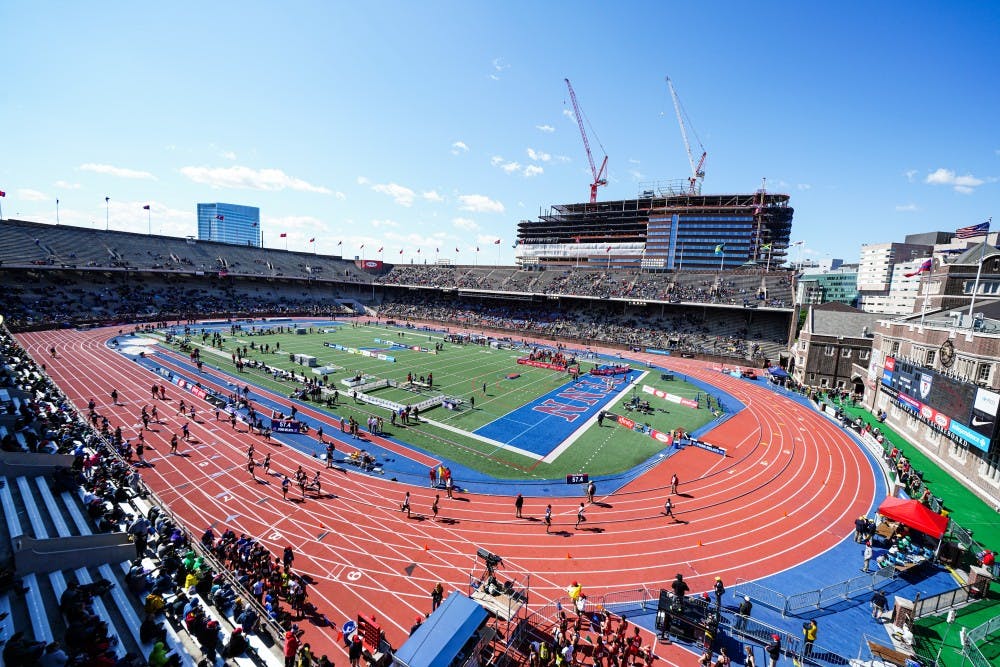Seasons come and go, but Franklin Field has stood the test of time. 125 years to be exact.
Over the past 125 years, Franklin Field has hosted a series of important games and events, cementing it as one of the most iconic features of Penn's campus.
Before the construction of Franklin Field, student-athletes would play on an open space located behind College Hall, the same area where the Quad is currently. In 1892, when the University needed a site to build the quad, its administrators applied for vacant city land east of campus for a new athletic field.
This vacant land was located at the intersection of 33rd and Spruce Streets, and with the help of alumni, the stadium was built by architects Frank Miles Day and Brother Charles Klauder. The overall cost of the construction was $100,000, which, in today’s money, is the equivalent of about 3 million dollars.
Franklin Field, named after Benjamin Franklin, first opened on April 20, 1895, with the first running of the Penn Relays. The chairman of Penn’s track committee at the time, Frank B. Ellis, was looking for an event to mark the dedication of the school’s new stadium.
The Penn Relays are the oldest and largest track and field meet in the United States. The relays bring competitors of all ages and talents to the historic stadium, and past attendees of the event include Usain Bolt and other Olympic athletes.
The prominent east coast teams that attended the first running included Harvard, Rutgers, Swarthmore, Cornell, Columbia, Lafayette and Lehigh. Yale and Princeton did not accept Penn’s invitation to attend. In addition to the college teams, local high school teams such as Germantown Academy, William Penn Charter, and Haverford Grammar School, also sent teams.
In its first 20 years, Franklin Field saw very few changes. In 1922, the stadium was renovated into a larger structure with more modern features like concrete stands. Three years later in 1925, the upper deck was added to increase the stadium’s capacity to 24,000 people. In 2004, SprinTurf and an electronic scoreboard and video board were added to help modernize the stadium. Currently, the stadium is going through another renovation to restore the lower east and upper south seating areas.
RELATED:
The best Penn teams of all time: 1897 Penn football
Penn Champions Club raises record-breaking $63.4 million for Penn Athletics
In 1938, President Franklin D. Roosevelt delivered his acceptance speech after being renominated for a second term as the Democratic representative at Franklin Field. Annually, Franklin Field is the site of commencement for the university.

Franklin Field in 1960s. (Photo from University Archives and Records Center)
For a period of 13 years, from 1958-1970, the Philadelphia Eagles played at Franklin Field. Franklin Field was the first NFL stadium to use artificial turf. The annual Army-Navy was also played at Franklin Field for 18 years between 1899 and 1935.
Franklin Field has been the setting of many firsts. It was the first stadium in the country to have a scoreboard. In 1922, the stadium was the site of the first football radio broadcast, and in 1929, it was the home of the first commercial football telecast. The stadium also hosted the NFL Championship Game in 1960.
From 1895 to 1924, there are records of Penn baseball playing their home games at Franklin Field.
The field was the site of the DI NCAA Men’s Lacrosse Championship in 1973 and 1992, and the DI NCAA Women’s Lacrosse Championship in May 2007.
The stadium usually opens around 6 AM and closes at 10 PM daily. On a slow day, Franklin field is in operation for about 12 hours and is used by many teams ranging from varsity to intramural.
The stadium even has a presence in the media. In the 2000 film Unbreakable, Bruce Willis plays a security guard at the field. In 2006, the movie Invincible was filmed at Franklin Field, which served as a stand in for the demolished Veterans Stadium.
To date, Franklin Field is the oldest college stadium in the country and is the current home of Penn Football, Sprint Football, Men’s and Women’s Lacrosse and Track and Field.









